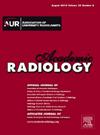Early and noninvasive prediction of response to neoadjuvant therapy for breast cancer via longitudinal ultrasound and MR deep learning: A multicentre study
IF 3.8
2区 医学
Q1 RADIOLOGY, NUCLEAR MEDICINE & MEDICAL IMAGING
引用次数: 0
Abstract
Rationale and Objectives
The early prediction of response to neoadjuvant chemotherapy (NAC) will aid in the development of personalized treatments for patients with breast cancer. This study investigated the value of longitudinal multimodal deep learning (DL) based on breast MR and ultrasound (US) in predicting pathological complete response (pCR) after NAC.
Materials and Methods
We retrospectively reviewed the pre-NAC and post-2nd-NAC MR and/or US images of 448 patients enrolled from three centers and extracted DL features from the largest section of the breast tumour using ResNet50. T test, Pearson correlation analysis and least absolute shrinkage and selection operator regression were used to select the most significant DL features for the pre-NAC and post-2nd-NAC MR and US DL models. The stacking model integrates different single-modality DL models and meaningful clinical data. The diagnostic performance of the models was evaluated.
Results
In all the patients, the pCR rate was 36.65%. There was no significant difference in diagnostic performance between the different single-modality DL models (DeLong test, p > 0.05). The stacking model integrating the above four DL models with HER2 status yielded areas under the curves of 0.951-0.979, accuracies of 91.55%–92.65%, sensitivities of 90.63%–93.94%, and specificities of 89.47%–94.44% in the cohorts.
Conclusion
Longitudinal multimodal DL can be useful in predicting pCR. The stacking model can be used as a new tool for the early noninvasive prediction of the response to NAC, as evidenced by its excellent performance, and therefore aid the development of personalized treatment strategies for patients with breast cancer.
通过纵向超声和磁共振深度学习对乳腺癌新辅助治疗反应进行早期无创预测:一项多中心研究。
理由和目标:早期预测对新辅助化疗(NAC)的反应将有助于开发针对乳腺癌患者的个性化治疗方法。本研究调查了基于乳腺 MR 和超声(US)的纵向多模态深度学习(DL)在预测新辅助化疗后病理完全反应(pCR)中的价值:我们回顾性地查看了来自三个中心的448例患者的NAC前和第2次NAC后的MR和/或US图像,并使用ResNet50从乳腺肿瘤的最大切片中提取了DL特征。通过T检验、皮尔逊相关分析、最小绝对收缩和选择算子回归,为NAC前和第2次NAC后的MR和US DL模型筛选出最重要的DL特征。堆叠模型整合了不同的单模态 DL 模型和有意义的临床数据。对模型的诊断性能进行了评估:所有患者的 pCR 率为 36.65%。不同单病种 DL 模型之间的诊断性能无明显差异(DeLong 检验,P > 0.05)。将上述四种 DL 模型与 HER2 状态整合的堆叠模型在队列中的曲线下面积为 0.951-0.979,准确率为 91.55%-92.65%,灵敏度为 90.63%-93.94%,特异性为 89.47%-94.44%:结论:纵向多模态 DL 可用于预测 pCR。叠加模型的出色表现证明,它可以作为一种新工具,用于早期无创预测对 NAC 的反应,从而帮助乳腺癌患者制定个性化治疗策略。
本文章由计算机程序翻译,如有差异,请以英文原文为准。
求助全文
约1分钟内获得全文
求助全文
来源期刊

Academic Radiology
医学-核医学
CiteScore
7.60
自引率
10.40%
发文量
432
审稿时长
18 days
期刊介绍:
Academic Radiology publishes original reports of clinical and laboratory investigations in diagnostic imaging, the diagnostic use of radioactive isotopes, computed tomography, positron emission tomography, magnetic resonance imaging, ultrasound, digital subtraction angiography, image-guided interventions and related techniques. It also includes brief technical reports describing original observations, techniques, and instrumental developments; state-of-the-art reports on clinical issues, new technology and other topics of current medical importance; meta-analyses; scientific studies and opinions on radiologic education; and letters to the Editor.
 求助内容:
求助内容: 应助结果提醒方式:
应助结果提醒方式:


